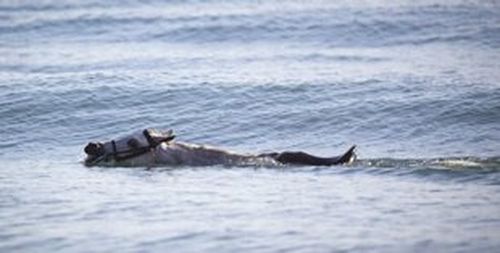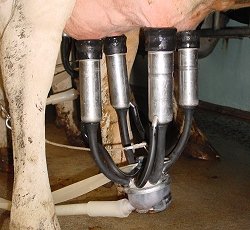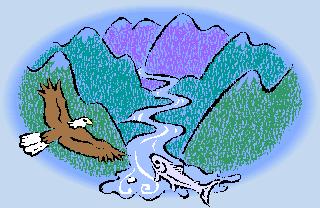Water News for May 2012
While you were dancing around the May Pole and shopping for a new bathing suit, a lot of important things happened in the world of water. Read on to hear all about it.
New Wind Turbine Can Manufacture Water from Thin Air
The French company Eole Water says that it has successfully modified the traditional wind turbine design to create the WMS1000, an appliance that can manufacture drinking water from humid air.
The company aims to start rolling out the giant products for sale later in 2012, initially focusing on remote communities in arid countries where water resources are scarce.
The product aims to make water available for traditionally water-challenged rural areas.
 |
New French Wind Turbine to Provide Water for Remote Areas |
More information about the Eole turbine.
Towns in Eastern Washington Are Running Out of Water
Some 25 communities in Eastern Washington could have their wells go dry within a decade. Some 200,000 people are included in the affected Odessa to Pasco, WA area.
The problem goes back to failure to complete projects associated with the building of Grand Coulee Dam in the 1940s.
The issue is simply that water is being taken from the Odessa Aquifer much faster than it can be recharged, and although more wells and deeper wells are being drilled, the water is expected to be gone in a decade. The full story.
Using Water from Wells Leads to Sea Level Rise
Science Daily reports that as people pump groundwater for irrigation, drinking water, and industrial uses, the water doesn’t just seep back into the ground — it also evaporates into the atmosphere, or runs off into rivers and canals, eventually emptying into the world’s oceans. This water adds up, and a new study calculates that by 2050, groundwater pumping will cause a global sea level rise of about 0.8 millimeters per year.
“Other than ice on land, the excessive groundwater extractions are fast becoming the most important terrestrial water contribution to sea level rise,” said Yoshihide Wada, with Utrecht University in the Netherlands and lead author of the study. In the coming decades, he noted, groundwater contributions to sea level rise are expected to become as significant as those of melting glaciers and ice caps outside of Greenland and the Antarctic. Read the rest of the story.
 |
| A 6-year-old Arabian horse named William, valued at $150,000, bolted during a beach photo shoot and swam more than two miles out to sea. After an ordeal that lasted almost 3 hours, the horse was rescued. He was exhausted and had some water in his lungs but is doing fine. More Details. |
A Hawaiian Bottled Water Company Was Fined $2 Million for Selling Unfiltered Water
Kona USA, a company that sells filtered ocean water from a deep-sea source off Kona, has agreed to pay the state department of health $2 million as part of a settlement in an enforcement case.
The state said Koyo USA diverted concentrated ocean water that had been rejected by its reverse osmosis system into its finished product.
No health issue was involved. Koyo USA was initially fined more than $5 million, but a $2 million settlement was reached.
The sordid details.
 |
California’s Central Valley is home to some of the state’s largest dairies, and in the Central Valley alone, cows generate the same amount of fecal waste as a city of 21 million people.
Much of this manure goes untreated and pollutes waterways.
Regulators are doing little to nothing to change this. Not only are the pollution levels frightening, but so too is the lack of care shown by the agency in charge of protecting groundwater supplies.
Read more details. |
Coastal Basements and Underground Utilities Will Be At Risk as Global Warming Advances
Basements of some coastal area buildings and underground utilities may be at risk of being inundated by rising groundwater by the end of the 21stcentury due to projected rates of sea level rise for the area, according to a preliminary study by the U. S. Geological Survey and Yale University.
“An underappreciated aspect of climate change is going to be the rising toll on property owners in the coastal zone from effects such as the one identified in this report-- rising ground water that produces water damage in basements that for decades and possibly a century were dry,” said USGS Director Marcia McNutt. “Utility bills will also rise to re-engineer utilities that were not designed to be installed completely above ground, as in the case in more temperate climates farther south.”
More Details.
Bottled Water Consumption in the US Increased for 2011
In 2011, total U.S. bottled water consumption increased to 9.1 billion gallons, up from 8.75 billion gallons in 2010 while consumption of other major beverages was down. Per-capita consumption is up 3.2 percent in 2011, with every person in America now drinking an average of 29.2 gallons of bottled water last year.
According to the International Bottled Water Association:
The bottled water industry is also utilizing a variety of measures to reduce our environmental footprint. All bottled water containers are 100 percent recyclable. Although bottled water makes up only 0.03 percent of the U.S. waste stream, according to the EPA, the bottled water industry works hard on a number of fronts with recycling advocates, communities, and our beverage and food partners to increase recycling rates. In fact, between 2000 and 2008, bottled water companies reduced the weight of PET resin plastic single-serve bottles by 32 percent. That is the equivalent of removing one out of three bottled water containers from the waste stream.
More details from the IBWA press release.
Vermont Ponders Fracking Ban
Vermont is about to become the first U.S. state to ban hydraulic fracturing, or fracking, for natural gas.
Fracking extracts natural gas by injecting millions of gallons of water, sand and chemicals under high pressure into shale rock formations to fracture the rock and release the gas. Giant holding ponds or tanks are needed to store the chemically contaminated waste water that comes back up the hole after wells have been fractured.
The Vermont House of Representatives voted 103-36 Friday to approve a conference committee report calling for the ban. The report reconciles differences with a bill banning the practice passed by the state Senate last week.
The measure now goes to the desk of Governor Peter Shumlin, a Democrat, who is expected to sign it into law.
Read more.
Important New Method for Removing Fluoride from Residential Tap Water Revealed
Fluoride, among the most challenging water treatment issues for residential users, can apparently be removed with relative ease using a newly described treatment method called simply the “Refrigerator Treatment.” The new approach is radical in that it uses only readily available items to accomplish what has been possible before only through high-tech reverse osmosis and activated alumina methodology.
Full details on this video.
Increased Burning of Fossil Fuels Is Making Oceans More Acidic
The oceans have always served as a sink for carbon dioxide, but the burning of fossil fuels since the beginning of the industrial revolution, especially over the last 40 years, has given them more than they can safely absorb.
The result is the gradual acidification of the oceans.
Changing something as fundamental as the pH of seawater — a measurement of how acid or alkaline it is — has profound effects. Increased acidity attacks the shells of shellfish and the skeletal foundation of corals, dissolving the calcium carbonate they’re made of. Coral reefs are among the most diverse ecosystems on the planet. Ocean acidification threatens the corals and every other species that makes its living on the reefs.
More Information from the New York Times.
Arizona State Study Demonstrates Effectiveness of Alternative Softeners
A study conducted last year by researchers at Arizona State University demonstrated that alternatives to domestic ion exchange water softening are effective at reducing scale.
The study, titled “Evaluations of Alternatives to Domestic Ion Exchange Water Softeners,” found that the most promising alternative technology template assisted crystallization, which demonstrated scale reductions of over 90 percent.
Methods studied were
• Capacitive Deionization
• Electrically Induced Precipitation
• Template Assisted Crystallization
• Electromagnetic Water Treatment
Full details.
"Fracking" and the Water Treatment Industry
by Hardly Waite
So now we know. Pigs are horses. Girls are boys. War is peace.--Arundhati Roy.
If you still have hope that the practice of hydraulic fracturing, a.k.a. "fracking," the use of high pressure water to help extract previously inaccessible shale gas, will because of ongoing "studies" be pronounced an environmental disaster and discontinued, don't hold your breath.
An advertisement for the 2nd Annual "Water Management for Shale Plays" event to be held in Denver in the summer of 2012 enthusiastically states that "a typical deep drilled shale well can take up to 4 to 5 million gallons" of water, and that "as the proliferation of drilling continues, effective water management for shale plays has become a matter of increasing urgency." This urgent need for water, of course, translates to high profits, for "managing water in the context of fracking has become a large, expensive, secondary industry where ever significant amounts of hydraulic fracturing are occurring."
In another context, the Wall Street Journal reports that Lux Research, a consulting group that provides "strategic advice and on-going intelligence for emerging technologies," in a recently issued report, states that with the advent of fracking, "the market for water treatment will grow nine-fold to $9 billion in 2020." This is yet another layer added to the bonds of financial interest that mere environmental concerns are competing with.
Here's part of the summation of that report from the Wall Street Journal's Market Watch page:
Fracking requires between 4,000 m(3) and over 22,000 m(3) (25,000 bbl to 140,000 bbl) of water per well and produces toxin-laced brine that can be more than six times as salty as the sea. Its growth has energized the water industry, inspiring a bumper crop of new water treatment startups vying to treat the highly challenging flowback water.
"Fracking represents a significant water treatment challenge -- hydrocarbons, heavy metals, scalants, microbes, and salts in produced and flowback water from shale gas wells represent a water treatment challenge on par with the most difficult industrial wastewaters," said Brent Giles, Lux Research Analyst and the lead author of the report titled, "Risk and Reward in the Frack Water Market."
"While the opportunity is large, only a few companies are really positioned to profit. Meanwhile, nearly every start-up we talk to is going after frack water, regardless of their technology, and many of them are going to come to grief," he added.
Lux Research positioned key companies on the Lux Innovation Grid based on their Technical Value and Business Execution -- companies that are strong on both axes reach the "Dominant" quadrant -- and also assessed each company's maturity, and provided an overall Lux Take. Among its findings:
-- WaterTectonics has technology and alliances. WaterTectonics' high-energy electrocoagulation technology addresses heavy metals, biological matter, and hydrocarbons, but leaves salt in place, meaning its use is restricted to areas where salt levels are moderate. Still, with its long-term alliance with Halliburton, WaterTectonics reaches the "Dominant" quadrant.
-- EcoSphere, AquaMost lead in oxidation technologies. EcoSphere combines ozone, cavitation, and electrochemistry, and the $9 million company leads in the "Dominant" quadrant. AquaMost, an early-stage startup, uses catalyzed UV to achieve many of the same results, but also removes metals. It ranks as "High potential" with strong technical value.
-- GasFrac is poised to disrupt the industry. GasFrac, with technology licensed from Chevron, uses high-pressure propane, rather than high-pressure water, to fracture gas wells. Its technology is being tested by Shell, Blackbrush, Husky, and Chevron, among others. With 300 employees, revenues of $300 million, and $50 million on hand, the profitable company outstrips every water start-up in our lineup, positioned in the "Dominant" quadrant and earning a "Strong Positive" Lux Take.
The report, titled "Risk and Reward in the Frack Water Market," is part of the Lux Research Water Intelligence Service.
So now we know. Pigs are horses, girls are boys, war is peace, and water pollution is financial opportunity.
With the likes of GasFrac, Water Techtonics, and Halliburton salivating as they envision dollar signs with billions after them, does it really matter what residential well owners say at community meetings and letters to congresspeople?
Minnesota Water Park Hit Hard by Cryptosporidiosis
 |
In spite of the smiling face of mascot Tiki Tom, it’s been a bad season for the Edgewood Resort and Water Park of Duluth, MN. Dozens of possible cases of cryptosporidiosis were traced to the water park last month. The costs in lost business and new technology could total a half-million dollars. Staff has been inundated with calls about the waterborne disease that causes flu-like symptoms. They’ve been hit with cancellations and forced to cut employee hours.
Bottom line: The resort has seen a 25 percent drop in bookings and revenues as its critical summer season approaches.
Full details from the Duluth News Tribune. |
An Important New Method for Removing Fluoride from Water Has Been Discovered. Full details on this video.
 |
Purifying Water With Plastic Bottles and Table Salt--Low Tech Solutions to Weighty Water Problems
by Pure Water Annie
|
When a city water plant sets about to make water potable--safe to drink--the first step is always to get rid of "turbidity," or cloudiness. This is often done by adding alum, to cause small particles to clump together, then filtering the water slowly through sand or another suitable particle-removal medium.
Clarifying the water is a necessary first step because particles in the water become hiding places for bacteria, and whether the purifying agent is a chemical (like chlorine or chloramine) or ultraviolet light, anything that offers a hiding place for microbes is undesirable.
It is fairly easy to purify clear water. A simple solar water disinfection method, called SODIS, calls for leaving a transparent plastic bottle of clear water out in the sun for six hours. That allows heat and ultraviolet radiation to wipe out most pathogens that cause diarrhea. Diarrhea kills 4,000 children a day in Africa.
The SODIS method, however, does not work if the water isn't clear. The microorganisms hide under the dirt or clay in the water and avoid the UV rays from the sunlight.
According to Science News, researchers at Queen's University in Ontario have discovered a simple, easy, and inexpensive way to clarify muddy water. Instead of alum, the chemical used by water suppliers, the simple method devised by the university researchers uses sodium chloride, plain table salt.
The salt promotes flocculation, causing the particles to clump together and settle out of the water.
"Salt is inexpensive and available almost everywhere. And it doesn't take very much to make muddy water clear again."
Although adding salt to the water isn’t ideal because the salt itself may influence its taste, the water, one researcher said, “has a lower sodium concentration than Gatorade.”
This would still be “too much salt to pass muster as American tap water, but American tap water is not the alternative.”
If the choice is diarrhea or slightly salty water, the decision is easy.
More information on this subject can be found in Science Daily.
 |
Numerical Wizard B. Bea Sharper ferrets out the watery facts that Harper's misses
The prodigious fecal droppings of non-canine animals. |
Introductory Note
by Gene Franks
Late last century, the Agriculture Committee of the U. S. Senate, directed by chairman Tom Harkin (D-Iowa), performed an extensive study of the state of our nation’s manure. Although the findings of Harkin’s committee were called “staggering” by the Associated Press, the story was essentially ignored except for a few page 22 newspaper stories. The Pure Water Gazette's numerical columnist, Bee Bea Sharper, intrigued by the big numbers that figure into animal manure statistics, turned the committee’s findings into a column. B. Bea’s numerical facts are taken from an excellent article on the Harkin findings, Pamela Rice’s “Everything You Never Wanted To Know About Manure,” which appeared in the Fall 1999 issue of Vegetarian Voice.
Keep in mind that these figures are now over a decade old, so it's certain that they have grown. Note also, that dogs, which B.B. focused on last month, don't hold a candle to farm animals when it comes to manure production.
-
Pounds of waste produced each year by farm animals in the United States-- 2.74 trillion.
-
If this waste were loaded on the boxcars of a single train, the number of times this train’s length would reach around the earth--12.5. [Editor's Note: We don't know why anyone would want to do this.]
-
Human population of a city that would create the same amount of excrement as the dairies in California’s Central Valley--21,000,000.
-
Estimated number of manure-generating animal-feeding operations in the United States-- 450,000.
-
Percentage of rivers that have been identified by the EPA as “impaired” in which agricultural runoff from animal waste is the largest problem-- 60%.
-
Number of Olympic-size swimming pools that would fit into one of the innumerable large “lagoons” (temporary excrement storage facilities) spread throughout the United States--200.
-
Percentage of the older lagoons in North Carolina that are leaking enough to contaminate groundwater-- 50%.
-
Number of separate noxious gasses that contribute to the foul odor which emanates from hog barns-- 150.
-
Number of dead birds that are composted or incinerated by the poultry industry each year-- 160,000,000.
-
Factor by which U.S. animal excrement exceeds human-- 130 times.
Pure Water Gazette Now in a New Format
Our information-stuffed variety magazine, the Pure Water Gazette, has taken another turn. The Gazette started as a paper publication in the 1980s. The last paper issue was mailed in 1997. It has existed since as an information-rich website whose navigation and aesthetic properties were suffering from years from neglect. Although the old site can still be seen here, the best of the old content has been relocated to a much more manageable blog-style format. The new site is up and running as a work in progress with well over 250 articles and many more to come. The new site is at the old location, http://www.purewatergazette.net. Please visit!
|
